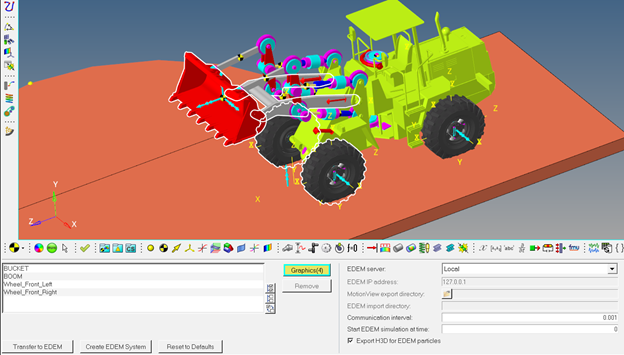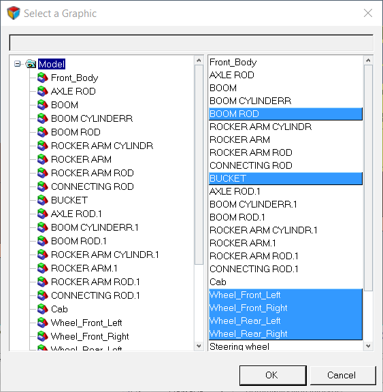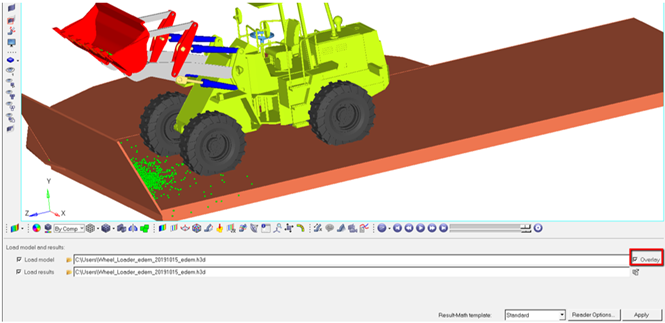Bulk Material Interaction
Starting in version 2019.1, MotionSolve supports co-simulation with the bulk material simulation interface EDEM® (now part of Altair). Through EDEM, users can simulate interaction of multi-bodies with granular materials such as stones, sand, grass, capsules etc.
Pre-requisites
- HyperWorks 2019.1 or later
- EDEM 2019.1 or later
Broad Steps for Co-simulation
- Define the system model in MotionView.
- Define the bulk material modeling in EDEM. Please refer to the EDEM manual (http://www.edemsimulation.com/resources-learning) for additional information on how to use EDEM.
- Use the
 EDEM Subsystem utility in MotionView to create a sub-system that contains the entities needed for the co-simulation. The
sub-system entails all components that interact with the bulk material. Optionally, the
graphics from MotionView can be transferred to EDEM using the
same utility.
EDEM Subsystem utility in MotionView to create a sub-system that contains the entities needed for the co-simulation. The
sub-system entails all components that interact with the bulk material. Optionally, the
graphics from MotionView can be transferred to EDEM using the
same utility. - Turn on the coupling server in EDEM while being in the Simulate mode.
- Start the MotionSolve simulation from the Run panel in MotionView.

Figure 1. The user-interface for creating an instance of the MotionSolve-EDEM interaction
Build Model using EDEM Subsystem
The EDEM subsystem tool assists in setting up of the co-simulation interface for MotionSolve with EDEM. Graphics from MotionView can also be transferred to EDEM using this tool. This is particularly useful when there are large number of components (such as a chain drive) that needs to be modeled in EDEM. From HyperWorks v2020, the interface is supported in Windows as well as Linux platforms. The interface can be used in cross-platform scenarios (HyperWorks on Windows and EDEM on Linux or vice-versa).
Figure 2. EDEM Subsystem Panel
- Activate the Graphics collector and pick the graphics that will
interact with the bulk material in EDEM. Graphics of type Box, Cylinder, Sphere,
Ellispoid, CADGraphics, FileGraphics can be selected from the graphics area. Tip: Use the Select a Graphic dialog to pick multiple graphics simultaneously (double click on the collector to display this dialog).

Figure 3. Select a Graphic Dialog - Select the EDEM server:
- Local if EDEM are running on the same local machine as MotionView and MotionSolve.
- Remote if EDEM is running on a different machine.
- EDEM IP address - Specify the IP address of the machine where EDEM application is running. Default is set to 127.0.0.1 which refers to the local machine.
- MotionView Export directory – This is applicable only for transferring geometry to EDEM on a remote server. Select a shared directory which is accessible by both machines. MotionView will use this directory as a temporary location to transfer the geometry.
- EDEM Import directory – Path string of the same shared directory as above but as recognized by the machine running EDEM.
- Specify the communication interval between MotionSolve and EDEM.
- To transfer geometry to EDEM, with the EDEM GUI on and coupling server turned ON
 , click on Transfer to EDEM to transfer
the selected graphics as geometries to EDEM.
, click on Transfer to EDEM to transfer
the selected graphics as geometries to EDEM. - Start EDEM simulation at time - Enter a time at which the EDEM simulation is starting. The coupling between MotionSolve and EDEM will be established once MotionSolve reaches the specified time. Default is 0.0.
- Export H3d for EDEM particles - With this option turned ON, an H3d will be generated for the EDEM particle simulation. Turn off this check box if EDEM H3d generation is not desired.
- Click on Create EDEM System to add a DEM system to the
MotionView model. This system contains the requisite entities for MotionSolve’s coupling with EDEM.Note: To change the IP address of the machine, the communication interval, or Start EDEM simulation at time after the system is created, use the dataset 'DataSet_1' within the system.

Figure 4. DataSet within the EDEM system
Analyze Model
- Use the Run Solver panel in MotionView/MotionSolve to start the simulation. MotionView will launch MotionSolve.

Figure 5. The user-interface for running a MotionSolve + EDEM simulation
Review Results
- Once the simulation is complete, use the Animate button in the MotionView Run panel to load the MotionSolve H3D into a HyperView window.
- Overlay the runfile_edem.h3d in HyperView using the Overlay option in the Load Model and Results panel to visualize the entire system in one environment.

Figure 6. The user-interface for overlaying a MotionSolve + EDEM simulation result
Known Limitations
- MotionSolve supports up to 1024 components to interact with EDEM.
- Multiple instances of EDEM coupling is not supported.
- Flexbodies and NLFE Bodies are not supported.
- Certain graphics when transferred to EDEM may appear un-merged as several components. Use the “Merge Geometry” tool in EDEM to merge them into one component.
- Interfacing with graphics belonging to Ground Body is not currently supported. The graphics may be transferred separately to EDEM (using the Discrete Element Method) without being included while creating the system in MotionView.
- Save/Load in MotionSolve, in conjunction with corresponding operations in EDEM, is not supported.
- Quasi-static and Linear analysis are not supported with this connection.
- On Windows if Microsoft C++ 2010 SP1 Redistributable Package (x64) is not available, then the co-simulation will fail with an error "Failed to load edem.dll".
In addition, see the following for additional information: